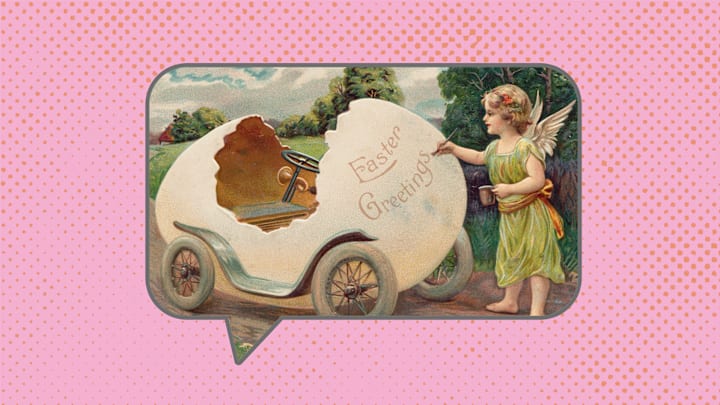The Spanish word for Easter is Pascua. In Italian, it’s Pasqua. French speakers have Pâques. All of these words derive from pascha—both Latin and Greek for Passover, the Jewish festival during which Jesus was supposedly resurrected.
Since English (unlike Spanish, Italian, and French) isn’t a Romance language, it’s not surprising that its word for the holiday bears no resemblance to those other three. Easter is often said to have been inspired by a different festival: that of the pagan goddess Eostre.
Eostre is a flowy-haired, flower-adorned woman with lots of rich lore. She represents rebirth, dawn, spring, and fertility; tales about her often feature rabbits and eggs. The general implication is that Christians took one long look at a pagan legend and shifted it wholesale onto their own holiday, right down to the name.
But the truth behind the word Easter is much murkier than that origin story suggests.
Bede Between the Lines

The oldest account of Eostre is found in the influential 8th-century work De Temporum Ratione, or The Reckoning of Time, by the Northumbrian monk and scholar Bede. According to him, the Old English term for the fourth month was “Eosturmonath … which is now translated ‘Paschal month,’ and which was once called after a goddess of theirs named Eostre, in whose honor feasts were celebrated in that month. Now they designate that Paschal season by her name, calling the joys of the new rite by the time-honored name of the old observance.”
With so little to go on, some scholars have questioned whether there ever was a deity named Eostre. Did Bede jump to conclusions about the meaning of Eostur, envisioning a goddess when it simply meant, say, “east” or “eastern”? It’s not impossible: Eostur likely shares a Germanic base with east, and that base is closely related to a batch of ancient words for dawn—owing to the sun’s rising in the east. We can’t say for sure that Eostur (or Eostre, as Bede rendered the term as a Latin moniker) was a goddess who personified the dawn of spring, or just a nod to the thing itself.
But there is circumstantial evidence to support Bede’s claim. For one thing, as historian Henry Mayr-Harting pointed out in The Coming of Christianity to Anglo-Saxon England, “it is possible that Bede’s father and almost certain that his grandfather could remember the heyday of Northumbrian heathenism.” In other words, Bede may have gotten his intel on Eostre’s festival from people who actually witnessed it.

We also know of Eosterwine, a.k.a. Easterwine, a 7th-century Northumbrian abbot whose name appears to have meant “Eostre’s follower.” Although “eastern friend” is another valid possibility, there’s a conspicuous lack of Anglo-Saxon names referring to northern, southern, or western friends. Meanwhile, several names do refer to followers or friends of a god or some other being—including Ingwine (Ing was a deity), Oswine (os meaning “god”), Freawine (“lord”), and Aelfwine (“elf”).
Not to mention that ancient history boasts a deep bench of dawn deities, from the Hindu goddess Usha (or Ushas) to Greek mythology’s Eos. In northwest Germany in 1958, remnants of ancient Roman altars were uncovered that bear an inscription to Matronae Austriahenae— apparently a group of mother goddesses whose name could be connected to Eostre. We don’t know if the goddesses themselves were related; all we know is that Eostre and the Austr- of Austriahenae are linguistically similar. All this to say that Eostre, if she existed, wasn’t the only goddess named for something eastern.
That’s a good way to sum up the etymology of the word Easter, too: It came from something eastern, be it a glorious deity or just an old root word. But believing Bede still leaves one question unanswered. If the only thing he told us about Eostre was her feast month, where did we get the rest of her lore?
Grimm Reaper

The short answer—as Richard Sermon explored in his book Easter: A Pagan Goddess, a Christian Holiday, & Their Contested History—is Germany. In the 17th century and beyond, German writers theorized pagan origins for their Easter-related terms and traditions. Easter in German is Ostern, which resembles a number of German place names—from Osterberg (berg meaning “mountain”) and Osterholz (holz is “wood”) to Osterndorf (dorf is “village”). Perhaps these were worship sites for Eostre, or “Ostera,” as one writer called her. Perhaps German Christians celebrated Easter with bonfires because their pagan progenitors had done the same to fete Ostera.
Jacob Grimm expanded this line of thinking in his 1835 book Deutsche Mythologie, describing “Ostara” as a goddess who “seems … to have been the divinity of the radiant dawn, of upspringing light, a spectacle that brings joy and blessing, whose meaning could be easily adapted to the resurrection-day of the christian’s God.” Grimm formed his portrait of Ostara from a mix of linguistics and knowledge of other dawn deities—not from any proof that people actually worshipped her.
Subsequent scholars added to Ostara’s legacy by using her to make sense of other German Easter customs. Adolf Holtzmann, for example, wrote in 1874 that Germany’s Easter hare (Osterhase) was “inexplicable” to him, “but probably the hare was the sacred animal of Ostara; just as there is a hare on the statue of [the Celtic goddess] Abnoba.”

By the early 20th century, Ostara had hopped from the realm of measured (albeit pretty speculative) academic theory into popular culture’s colorful imagination. Depictions proliferated of an ethereal and often vaguely Greco-Roman fairy goddess surrounded by Easter iconography. In 1903, one Baptist reverend wrote that Ostara’s festival “was originally observed in a most hilarious manner, by nude dancers who indulged in the foulest immoralities.”
These sources are now old enough that we tend to take them at face value; careful phrasing like Grimm’s “seems” and Holtzmann’s “inexplicable” and “probably” gets buried beneath the Ostara legends that their work helped inspire. In short, an ancient goddess may have given us the word Easter—but modern folks gave that goddess an identity.
Learn More About Easter:
